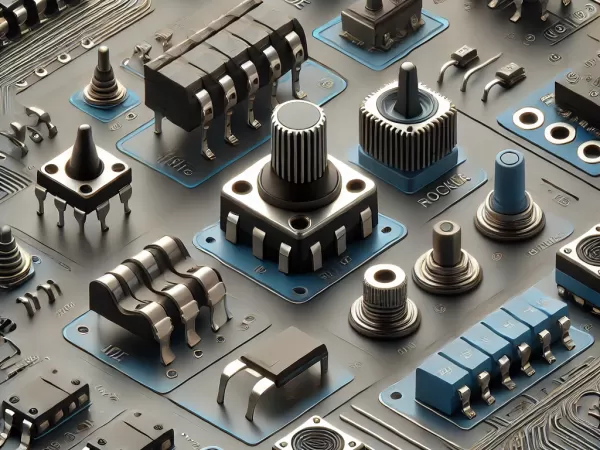A must-have for design engineers: Flexible application guide for dip switches

In electronic device design, choosing the right components is crucial to the success of the entire system. As a simple and effective configuration tool, dip switches are widely used in various devices and circuit designs due to their flexibility and ease of use. This article will provide design engineers with an application guide for dip switches to help you make full use of this small and powerful component in your project.
What is a dip switch?
A DIP switch (full name Dual In-line Package Switch) is a mechanical switch used to configure and set up circuits. It controls the function, mode or configuration in a device or circuit through a simple "on/off" state. Each switch bit can be set to "on" or "off", and these states represent binary values. Engineers can achieve complex functional control by combining different switch states.
Advantages of DIP switches
The advantage of a dip switch is that it does not require any programming skills. By physically sliding the switch, users can easily set the mode or switch the function of the device. This intuitive operation is particularly suitable for scenarios that require quick configuration, such as factory equipment commissioning or hardware settings during development.
The number of digits of each DIP switch determines the number of configurations that can be realized. For example, a 4-digit DIP switch can realize 24=162^4 = 1624=16 different combinations. Engineers can choose DIP switches with different digits according to project requirements and flexibly adjust the configuration of the equipment.
High reliability As a mechanical switch, the dip switch does not rely on power supply and can work stably in various environments. Compared with software configuration, the dip switch will not be affected by system crashes or electrical interference and has extremely high reliability.
Application scenarios of DIP switches
The application of DIP switches covers a wide range of industries and scenarios, from household appliances to industrial equipment to consumer electronics. The following are some common applications of DIP switches:
Communication and Network Equipment In communication equipment such as routers and switches, dip switches are often used to configure network protocols or set IP addresses. Users can quickly modify the network parameters of the device by manually adjusting the dip switches without complicated operation procedures.
Embedded System DevelopmentDip switches are widely used in embedded system design. With dip switches, engineers can easily change the input/output configuration of the microcontroller, select the working mode, and even run the device under different test conditions. This simple configuration method greatly improves development efficiency.
Home Appliances and Consumer Electronics In home appliances, DIP switches are used for mode selection and safety settings. For example, users can quickly adjust the operating mode of the air conditioner, the temperature setting of the heater, and even the function options of some small electronic devices through DIP switches.
Industrial Equipment In industrial automation equipment, dip switches are used to select the machine's operating mode, configure communication addresses, or adjust the equipment's operating parameters. Since high reliability is usually required in industrial environments, dip switches, as mechanical configuration tools, can operate stably in harsh environments.
Key parameters for selecting DIP switches
When designing a DIP switch, design engineers need to consider the following important parameters based on project requirements:
Positions The number of positions of a DIP switch determines the number of combinations that can be set. Choosing the right number of positions based on application requirements is the first thing engineers need to consider. For example, in a device that requires multiple options to be configured, choosing a DIP switch with more positions can provide greater flexibility.
The voltage and current specifications of the DIP switch must meet the requirements of the circuit. Common electrical parameters include rated current (such as 100mA or higher) and rated voltage (such as 24V, 250V, etc.). It is critical to ensure that the DIP switch can withstand the voltage and current load in the system.
Installation method The dip switch can be installed on the circuit board by through-hole or surface mount. Through-hole is suitable for traditional circuit design, while surface mount is more suitable for modern automated production process.
Durability and environmental adaptability According to the working environment of the equipment, select a DIP switch with a wide temperature range and protection level to ensure that the equipment can still work normally under extreme conditions such as high temperature and humidity.
How to optimize the use of DIP switches in a project?
Simplify user operation Design engineers can simplify user operation by mapping the combination of dip switches to user-friendly function settings. For example, directly mapping the switch position to the specific function of the device makes it easy for users to get started quickly.
Use labels and instructions In the design of DIP switches, adding clear labels or instructions to each switch can help users understand the functions corresponding to each switch position and avoid misoperation.
Designing redundancy into critical equipment In some critical industrial equipment or embedded systems, dual DIP switch configurations can be used to provide redundant design to improve reliability and prevent problems caused by single switch failure.
With its simplicity, reliability and flexibility, DIP switches have become an indispensable tool for design engineers in equipment configuration and control. Whether in home appliances, industrial control equipment, or embedded system development, DIP switches can help engineers achieve complex functional configurations through physical switches. For engineers, mastering the application skills and selection criteria of DIP switches will help improve the efficiency and reliability of equipment design.
No matter how complex your project is, DIP switches can be an ideal choice for simplifying control and configuration. If you need to customize and design a DIP switch, we are happy to provide more solutions and designs and discuss with you.